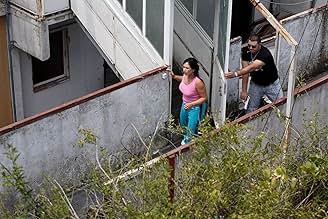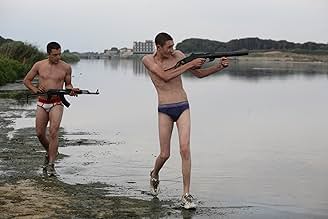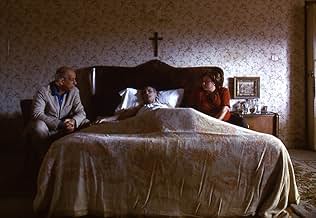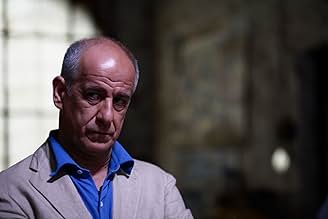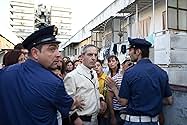IMDb रेटिंग
7.0/10
53 हज़ार
आपकी रेटिंग
स्कम्पिया वेले एक कोरबेशियन वास्तुकलाा है जो नेपल्स, इटली के माफिया के लिए एक गढ़ बन गया है.स्कम्पिया वेले एक कोरबेशियन वास्तुकलाा है जो नेपल्स, इटली के माफिया के लिए एक गढ़ बन गया है.स्कम्पिया वेले एक कोरबेशियन वास्तुकलाा है जो नेपल्स, इटली के माफिया के लिए एक गढ़ बन गया है.
- 1 BAFTA अवार्ड के लिए नामांकित
- 34 जीत और कुल 42 नामांकन
Salvatore Abbruzzese
- Totò
- (as Salvatore Abruzzese)
Vincenzo Altamura
- Gaetano
- (as Gaetano Altamura)
फ़ीचर्ड समीक्षाएं
Some publications gave Gomorra a perfect rating, while others gave more basic reviews but, in a week where The Times reviewed about 10 new releases and gave this 5 stars and everything else 1 or 2, I decided this was a film I should check out and that The House Bunny could perhaps wait for another time (specifically, when it is the last film on Earth). Gomorra opens with a beauty salon hit which I imagine is meant to introduce us to the violent and treacherous world of the Cammora crime syndicate in the locality of Naples, Italy. As an impacting opening, it does work but the "introduction" idea is sadly where the film is roundly weak and it does mean that it has the potential to confuse.
Before I get a barrage of messages pointing out to me that cousins shouldn't marry, I do not mean that I could not follow the specific threads of the film but just that the film offers nothing to inform the new viewer of the world that we are about to enter. I'm not sure the best of doing this but certainly at first I didn't totally appreciate the scale of the organisation, the structure or the setting and it took me a minute as a result to get into the stories. Unlike similar films, the separate threads never really come together in any way other than they share a grounding in location and the problem of the Cammora. Outside of a specific introduction for those coming in cold, the film does give a sort of introduction to the problem as we first follow one of the characters around the nightmarish, enclosed estate of flats which seems to perform the task of judge and prison-officer as those born into it have little opportunity to escape it and essentially have their fate sealed by virtue of their environment.
Within this feat of architecture we follow several threads including a money-man, a boy getting into the life on the lowest rung, a man starting out in the corrupt world of waste management, a black-market tailor looking to earn a bit more on the side and two young men who decide to seize power in their region from the old, fat men who sit at the top. In terms of engagement, there isn't really a huge emotional draw within the film but instead it all feels very realistic and dead - so it is not so much that you feel for the specific characters so much as you have a constant sense of hopelessness and of how small and petty it all it. This is not the Italian gangsterisms of The Godfather where there is a certain sense of class and aspiration, in Gomorra the top men are trapped in the world the same as everyone else - with more money perhaps but they are not living in mansions or controlling things from a tropical island. The delivery of the film helps this as it is well shot on location and has a hand-held feel of grit and dirt. I didn't really like the technique employed throughout where the focus was on the subject in the close foreground and everything else was blurred, even as it came into play in the scene but otherwise it was well done, with the sudden moments of violence made more impacting by not being seen due to confusion simulated in the camera or by quick editing.
Gomorra has been compared to City of God, Goodfellas and all the other crime films that get wheeled out for reviews. In most ways this is not really a fair description because Gomorra does not have the style and flair of those films, nor do all the narrative threads come together neatly in the way we have come to expect. However it is still an engagingly bleak and realistic look into the world of the Cammora that is well done even if it has flaws. It is not "enjoyable" per se due to the lack of flair, but it is a very good film nonetheless and, like City of God did with City of Men, it offers the potential for a mini-series to further explore and find stories from within this world.
Before I get a barrage of messages pointing out to me that cousins shouldn't marry, I do not mean that I could not follow the specific threads of the film but just that the film offers nothing to inform the new viewer of the world that we are about to enter. I'm not sure the best of doing this but certainly at first I didn't totally appreciate the scale of the organisation, the structure or the setting and it took me a minute as a result to get into the stories. Unlike similar films, the separate threads never really come together in any way other than they share a grounding in location and the problem of the Cammora. Outside of a specific introduction for those coming in cold, the film does give a sort of introduction to the problem as we first follow one of the characters around the nightmarish, enclosed estate of flats which seems to perform the task of judge and prison-officer as those born into it have little opportunity to escape it and essentially have their fate sealed by virtue of their environment.
Within this feat of architecture we follow several threads including a money-man, a boy getting into the life on the lowest rung, a man starting out in the corrupt world of waste management, a black-market tailor looking to earn a bit more on the side and two young men who decide to seize power in their region from the old, fat men who sit at the top. In terms of engagement, there isn't really a huge emotional draw within the film but instead it all feels very realistic and dead - so it is not so much that you feel for the specific characters so much as you have a constant sense of hopelessness and of how small and petty it all it. This is not the Italian gangsterisms of The Godfather where there is a certain sense of class and aspiration, in Gomorra the top men are trapped in the world the same as everyone else - with more money perhaps but they are not living in mansions or controlling things from a tropical island. The delivery of the film helps this as it is well shot on location and has a hand-held feel of grit and dirt. I didn't really like the technique employed throughout where the focus was on the subject in the close foreground and everything else was blurred, even as it came into play in the scene but otherwise it was well done, with the sudden moments of violence made more impacting by not being seen due to confusion simulated in the camera or by quick editing.
Gomorra has been compared to City of God, Goodfellas and all the other crime films that get wheeled out for reviews. In most ways this is not really a fair description because Gomorra does not have the style and flair of those films, nor do all the narrative threads come together neatly in the way we have come to expect. However it is still an engagingly bleak and realistic look into the world of the Cammora that is well done even if it has flaws. It is not "enjoyable" per se due to the lack of flair, but it is a very good film nonetheless and, like City of God did with City of Men, it offers the potential for a mini-series to further explore and find stories from within this world.
This is a collection of five stories about people who are touched by the gritty Neapolitan crime world. There is a gang war erupting. Don Ciro is a scared middleman. He is jumped by the other side and forced to take them back to his location. Roberto works in waste management and his boss Franco is dumping toxic wastes. Pasquale works as a high fashion tailor controlled by the mob. He moonlights for their Chinese competitor but it goes wrong. Marco and Ciro are young gangster wannabes. They get in over their heads.
This is a great faux-realistic take on the modern mob. It opens with a bang. I will always remember the waste disposal because of the subject matter. The two youngsters are probably the most compelling characters. There are some ups and downs. It's a disjointed watch. It's a wide-ranging take on the subject and proves to be an effective one.
This is a great faux-realistic take on the modern mob. It opens with a bang. I will always remember the waste disposal because of the subject matter. The two youngsters are probably the most compelling characters. There are some ups and downs. It's a disjointed watch. It's a wide-ranging take on the subject and proves to be an effective one.
A realistic film about the Neapolitan Mafia, The movie has a documentary touch which i really liked the most, the ending is perfect and real.
A must-see!
In 2003, Giancarlo De Cataldo, a judge-turned-novelist, wrote Romanzo Criminale (Crime Novel in English), a largely truthful recollection (only the names were changed) of the Magliana gang, a Roman crime organization he had sentenced to prison. Three years later, Neapolitan journalist Roberto Saviano wrote Gomorra, a first-hand, non-fiction analysis of how organized crime controls everything in his native region. The book was the result of months of direct contact with the people who keep the System (the gangsters themselves refuse to use the word Camorra, which can be considered the local version of the Sicilian Mafia) and became a huge success, the downside of which was Saviano receiving multiple death threats from the people he'd exposed and being forced to live with a permanent police escort. The reason I'm mentioning both books is they were both made into successful films (Gomorra even walked away with the Grand Prize of the Jury at the 2008 Cannes Film Festival), with one crucial difference: Romanzo Criminale is very good, but does at times, as implied by the title, feel like a novel, a fictional story. Gomorra, on the other hand, using the same raw, in-your-face style as City of God, throws the viewer into a new, scary world - the real deal.
Director Matteo Garrone, who co-wrote the screenplay with a bunch of collaborators (including Saviano himself), wisely decides to ditch the book's first-person storytelling, the only (possible) reference to the author being a young man named Roberto who helps businessman Franco (Toni Servillo) close a series of suspicious deals with various companies in the North of Italy (Venice is explicitly shown). Franco's line of work, which will sound amusing to anyone who's watched The Sopranos, is waste management, though not of the legal kind. His story is one of five that constitute the film's narrative: along with him, there's also Don Ciro (Gianfelice Imparato), who pays the family members of imprisoned crooks; Pasquale (Salvatore Cantalupo), a tailor whose life is at risk because of his contacts with the Chinese (Italians don't like competition) and whose work ends up being worn by celebrities like Scarlett Johansson (Angelina Jolie in the book); and then there are two different examples of young blood, one a loyal boy who runs errands for his drug-dealing neighbors, the other two young punks who have watched Scarface way too often (a reference to the fact that a real-life Camorra boss had his villa designed exactly like Tony Montana's) and think they can take over.
An ensemble gangster flick, then. Not quite: this is no Altman movie, which means the separate plot strands never once cross paths. This is because Gomorra doesn't set out to be a real, straightforward story, but rather offer a series of bleak, extremely real examples of how the Camorra (or the System, though neither word is ever spoken in the film) controls everything. Aside from the documentary-style cinematography and anxious cutting, the highest degree of realism comes from the cast: the only really famous actor in the film is Servillo, familiar from Paolo Sorrentino's filmography; the rest have a theatrical background or, in the case of the kids especially, were taken directly from the street (the movie was shot on location, and rumor has it the mother of a Camorra boss asked for a cameo). This shows most clearly in the way they speak: with few exceptions (Franco most notably), the characters' Neapolitan dialect is so strong the film had to be subtitled in most parts of Italy. Garrone and Saviano's message is clear: this isn't your usual genre flick, it's something else - something palpable, something real, something terrifying.
Gomorra's top achievement is that it doesn't play to the stereotype of Italy being nothing but the home of gangsters. On the contrary, it pinpoints a sad fact, its intent being to denounce and make aware, never to glorify. Sure, it opens with a shootout that could remind of Goodfellas (still one of the best first-hand crime tales) or The Sopranos, but even those masterpieces are too smooth and polished next to the gritty, unsettling universe that emerges from this film. It's dirty, brutal, scary. And it simply has to be seen.
Director Matteo Garrone, who co-wrote the screenplay with a bunch of collaborators (including Saviano himself), wisely decides to ditch the book's first-person storytelling, the only (possible) reference to the author being a young man named Roberto who helps businessman Franco (Toni Servillo) close a series of suspicious deals with various companies in the North of Italy (Venice is explicitly shown). Franco's line of work, which will sound amusing to anyone who's watched The Sopranos, is waste management, though not of the legal kind. His story is one of five that constitute the film's narrative: along with him, there's also Don Ciro (Gianfelice Imparato), who pays the family members of imprisoned crooks; Pasquale (Salvatore Cantalupo), a tailor whose life is at risk because of his contacts with the Chinese (Italians don't like competition) and whose work ends up being worn by celebrities like Scarlett Johansson (Angelina Jolie in the book); and then there are two different examples of young blood, one a loyal boy who runs errands for his drug-dealing neighbors, the other two young punks who have watched Scarface way too often (a reference to the fact that a real-life Camorra boss had his villa designed exactly like Tony Montana's) and think they can take over.
An ensemble gangster flick, then. Not quite: this is no Altman movie, which means the separate plot strands never once cross paths. This is because Gomorra doesn't set out to be a real, straightforward story, but rather offer a series of bleak, extremely real examples of how the Camorra (or the System, though neither word is ever spoken in the film) controls everything. Aside from the documentary-style cinematography and anxious cutting, the highest degree of realism comes from the cast: the only really famous actor in the film is Servillo, familiar from Paolo Sorrentino's filmography; the rest have a theatrical background or, in the case of the kids especially, were taken directly from the street (the movie was shot on location, and rumor has it the mother of a Camorra boss asked for a cameo). This shows most clearly in the way they speak: with few exceptions (Franco most notably), the characters' Neapolitan dialect is so strong the film had to be subtitled in most parts of Italy. Garrone and Saviano's message is clear: this isn't your usual genre flick, it's something else - something palpable, something real, something terrifying.
Gomorra's top achievement is that it doesn't play to the stereotype of Italy being nothing but the home of gangsters. On the contrary, it pinpoints a sad fact, its intent being to denounce and make aware, never to glorify. Sure, it opens with a shootout that could remind of Goodfellas (still one of the best first-hand crime tales) or The Sopranos, but even those masterpieces are too smooth and polished next to the gritty, unsettling universe that emerges from this film. It's dirty, brutal, scary. And it simply has to be seen.
Gomorra (2008) ****
Much of Gomorra takes place in and around a crumbling housing project, that in establishing shots looks as if it were a rotting labyrinth pyramid. The very structure of the film's slums serves itself as a visual metaphor for the Camorra crime institution in Naples. It's a bureaucratic shuffle, rivaling a large capitalist corporation, equally ruthless but in different senses of the term. Their products are drugs, extortion, and toxic sludge. Their version of corporate take-over involves murderously shameless acts of extreme violence.
Matteo Garrone deftly directs Gomorra, based on the novel of the same name by Roberto Saviano. It contains a labyrinth plot serving to depict a labyrinth lifestyle. One storyline focuses on a young boy, Toto, who lives in that decaying pyramid, and wants to join up with the gangsters who run it. By the end of the film, his youth will be shattered, and he'll have done things to those around him that would have seemed unthinkable before. He's the ground soldier in the gangster empire.
Don Ciro is an aging money runner, delivering rations to the families of mob prisoners. He gets increasingly caught between the war between factions within the complexes, and before long takes to wearing a bullet proof vest in fear of his own safety.
Roberto is a college graduate, given a high profile job working with Franco, who runs a scheme disposing of garbage and waste from the city by burying it in the countryside - a move that has sent the cancer rate in the countryside through the roof. Roberto must face his own conscious as he becomes more and more aware of the corruption of work.
Pasquale is a talented designer, who's put to work by his friend and boss completing a contract for dresses in less time than he and the workers should like. At great personal risk to himself, he takes an offer from a Chinese factory boss to gives lessons to his workers. The job means crossing the Comorra, so he is hidden in the trunk on the drive to the factory, with a modified hole behind the backseat so he can stick his head out to breath and chat.
The other storyline follows two Scarface-wannabes who long to be the crime bosses of all bosses. They cross the local boss by stealing drugs from dealers, causing trouble, then by stealing weapons from a mob cache, raising Cain. They are knuckle-heads, a couple of kids too stupid to see the truth behind the phony glorification of the gangster lifestyle.
That phony glorification is entirely absent here. Garrone observes his gangsters with an eye of contempt. There is no Robin Hood imagery in Gomorra. It puts on full display the ruthlessness of the gangster culture. It's a gangster as capitalist world, one where turning to killing kids or a woman is looked down upon, but not off-limits.
The film starts off with a fantastic sequence of tanning machines and surprisingly graphic murder, which would lead one to think that they were moving headlong into a Scorsese-like blood bath of macabre. You'd be wrong though. Gomorra is a very patient film, slowly unraveling its stories. It's clearly influenced by the early Italian Neo-Realists, and also has elements that reminded me of the gangster pictures of Jean-Pierre Melville. Garrone shoots in a documentary style with hand-held camera shots. It jumps between its story lines with utmost patience, which might slow down the film's pace more than many would like or are accustomed to. If you do not realize the scope of the Camorra's activity in nearly all facets of commercial and communal life in and around Naples, the connection between the stories may seem unclear. But that's one of the main services of the picture, to show us just how entrenched the mafia has remained in parts of Italy.
Although mob movies are a dime a dozen, Gamorra enters as a gangster epic with freshness. It's a very European film, and as far as gangster pictures go, with its no nonsense documentary style, and only slowly escalating violence and patience it feels like a unique addition to the genre. Gomorra is sure to split, maybe even downright annoy audiences looking for something more conventional. It defies at least most of the genre's clichés, and aims high with its quiet ambitions.
Gomorra won the Grand Prix at this year's Cannes Film Festival, and has been slotted as Italy's official entry into the 2009 Academy Awards for Best Foreign Film.
Much of Gomorra takes place in and around a crumbling housing project, that in establishing shots looks as if it were a rotting labyrinth pyramid. The very structure of the film's slums serves itself as a visual metaphor for the Camorra crime institution in Naples. It's a bureaucratic shuffle, rivaling a large capitalist corporation, equally ruthless but in different senses of the term. Their products are drugs, extortion, and toxic sludge. Their version of corporate take-over involves murderously shameless acts of extreme violence.
Matteo Garrone deftly directs Gomorra, based on the novel of the same name by Roberto Saviano. It contains a labyrinth plot serving to depict a labyrinth lifestyle. One storyline focuses on a young boy, Toto, who lives in that decaying pyramid, and wants to join up with the gangsters who run it. By the end of the film, his youth will be shattered, and he'll have done things to those around him that would have seemed unthinkable before. He's the ground soldier in the gangster empire.
Don Ciro is an aging money runner, delivering rations to the families of mob prisoners. He gets increasingly caught between the war between factions within the complexes, and before long takes to wearing a bullet proof vest in fear of his own safety.
Roberto is a college graduate, given a high profile job working with Franco, who runs a scheme disposing of garbage and waste from the city by burying it in the countryside - a move that has sent the cancer rate in the countryside through the roof. Roberto must face his own conscious as he becomes more and more aware of the corruption of work.
Pasquale is a talented designer, who's put to work by his friend and boss completing a contract for dresses in less time than he and the workers should like. At great personal risk to himself, he takes an offer from a Chinese factory boss to gives lessons to his workers. The job means crossing the Comorra, so he is hidden in the trunk on the drive to the factory, with a modified hole behind the backseat so he can stick his head out to breath and chat.
The other storyline follows two Scarface-wannabes who long to be the crime bosses of all bosses. They cross the local boss by stealing drugs from dealers, causing trouble, then by stealing weapons from a mob cache, raising Cain. They are knuckle-heads, a couple of kids too stupid to see the truth behind the phony glorification of the gangster lifestyle.
That phony glorification is entirely absent here. Garrone observes his gangsters with an eye of contempt. There is no Robin Hood imagery in Gomorra. It puts on full display the ruthlessness of the gangster culture. It's a gangster as capitalist world, one where turning to killing kids or a woman is looked down upon, but not off-limits.
The film starts off with a fantastic sequence of tanning machines and surprisingly graphic murder, which would lead one to think that they were moving headlong into a Scorsese-like blood bath of macabre. You'd be wrong though. Gomorra is a very patient film, slowly unraveling its stories. It's clearly influenced by the early Italian Neo-Realists, and also has elements that reminded me of the gangster pictures of Jean-Pierre Melville. Garrone shoots in a documentary style with hand-held camera shots. It jumps between its story lines with utmost patience, which might slow down the film's pace more than many would like or are accustomed to. If you do not realize the scope of the Camorra's activity in nearly all facets of commercial and communal life in and around Naples, the connection between the stories may seem unclear. But that's one of the main services of the picture, to show us just how entrenched the mafia has remained in parts of Italy.
Although mob movies are a dime a dozen, Gamorra enters as a gangster epic with freshness. It's a very European film, and as far as gangster pictures go, with its no nonsense documentary style, and only slowly escalating violence and patience it feels like a unique addition to the genre. Gomorra is sure to split, maybe even downright annoy audiences looking for something more conventional. It defies at least most of the genre's clichés, and aims high with its quiet ambitions.
Gomorra won the Grand Prix at this year's Cannes Film Festival, and has been slotted as Italy's official entry into the 2009 Academy Awards for Best Foreign Film.
क्या आपको पता है
- ट्रिवियाRoberto Saviano got death threats from the Camorra for exposing their activities in the novel and movie, and is now permanently under police protection.
- गूफ़At the beginning of the movie you can clearly see the character named Amerigo belly moving, when his dead body remains on the chair, where he has been having his nails cut.
- इसके अलावा अन्य वर्जनIn 2020 Matteo Garrone re-cut the movie, reducing the length to 125 minutes.
- कनेक्शनFeatured in De wereld draait door: एपिसोड #4.31 (2008)
- साउंडट्रैकHerculaneum
Written by Robert Del Naja and Neil Davidge
Performed by Massive Attack
Additional programming by Euan Dickinson
Courtesy of One Point Six
टॉप पसंद
रेटिंग देने के लिए साइन-इन करें और वैयक्तिकृत सुझावों के लिए वॉचलिस्ट करें
विवरण
बॉक्स ऑफ़िस
- US और कनाडा में सकल
- $15,79,146
- US और कनाडा में पहले सप्ताह में कुल कमाई
- $5,532
- 21 दिस॰ 2008
- दुनिया भर में सकल
- $3,48,61,529
- चलने की अवधि
- 2 घं 17 मि(137 min)
- रंग
- ध्वनि मिश्रण
- पक्ष अनुपात
- 2.35 : 1
इस पेज में योगदान दें
किसी बदलाव का सुझाव दें या अनुपलब्ध कॉन्टेंट जोड़ें

![Trailer originale italiano [OV] देखें](https://m.media-amazon.com/images/M/MV5BMjYxMDk3OTItZDQxNC00MTlkLTlkNGYtZWVhMzgzM2M5NWFmXkEyXkFqcGdeQXRyYW5zY29kZS13b3JrZmxvdw@@._V1_QL75_UY281_CR13)


